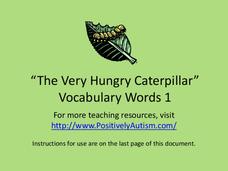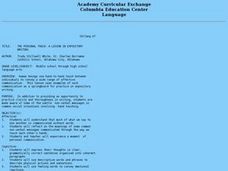Curated OER
Alexander and the Terrible, Horrible, No Good, Very Bad Day
Students investigate storytelling by analyzing images in a book. In this reading analysis activity, students read and analyze the book Alexander and the Horrible, No Good, Very Bad Day. Students observe the illustrations in...
Curated OER
Tennis Playing Family
In this secondary mathematics worksheet, students use logical thinking to solve a verbal problems in which they determine who is the worst tennis player in a family. The one page worksheet contains one problem with the solution.
Curated OER
Calculating rates
In this Algebra I/Algebra II learning exercise, students solve verbal problems in which they calculate rates using the appropriate unit of measure. The one page learning exercise contains a combination of seven multiple choice and...
Curated OER
Calculate Rates Using Appropriate Units
In this Algebra I/Algebra II worksheet, students solve verbal problems in which they calculate the indicated rate and choose the appropriate unit of measurement. The three page worksheet contains a combination of nineteen multiple...
Curated OER
Graphing Situations without a Table
Students graph a line without making a table of vales. In this algebra lesson plan, students are given a verbal scenario and asked to write a linear functions representing the scenario and graph it on a number line without making a...
Curated OER
Classroom Guide for Grandfather Counts
Students explore Asian American culture. In this multicultural guided reading lesson, students brainstorm a list of communication tools and share languages they speak. Students read Grandfather Counts by Andrea Cheng, then discuss the...
Curated OER
Persona Interests, Likes, and Dislikes
Students practice listening to and discussing their personal interests and opinions. In this communication lesson, students listen as the teacher talks about his/her personal interest. They work with a partner to verbally share their own...
Curated OER
Cotton
Discover facts about cotton, farming, and economic growth in this engaging lesson. As each question is read, one of ten solid tiles covering an illustration of a cotton plant is removed. Students use the verbal and visual clues to...
Advocates for Youth
Creating Safe Space for GLBTQ Youth: A Toolkit
Students identify human psychology by examining role-playing situations. For this homosexuality lesson, students identify what it means to be a gay or lesbian person and discuss the appropriate behavior to interacting with gay and...
Curated OER
Teenagers
In this fast-paced activity, learners identify the order of numbers from 13 to 20. They practice greater than and less than with verbal responses to pairs of numbers. Suggested accompaniments include counting forward and backward to 20....
Curated OER
Attributes of Shapes
There are five shapes for scholars to identify: rectangle, circle, square, trapezoid, and triangle. Although there isn't much here, consider projecting this as an all-class warm up. Ask kids to verbalize attributes of each...
Curated OER
Dollars and Cents Word Problems
These are some cheap items! Learners explore cost with this addition word problem which has them examine the price of a baseball and a pencil. They add them together to find the total spent. Because there is an explanation below,...
All Our Days
Duplo/Lego Tower Pattern Busy Bag
Turn young learners into pattern detectives with this fun hands-on activity. Using the included set of cards showing different block towers, children replicate each pattern with their own manipulatives while...
SurfScore
Kodable
Prepare young scholars for life in the twenty-first century with this introduction to computer coding formatted as a fun problem solving game, this resource is a great way to develop children's sequential thinking...
Positively Autism
The Very Hungry Caterpillar Vocabulary
Moon, eggs, leaf, sun, caterpillar. Prior to reading Eric Carle's classic tale, introduce vocabulary for The Very Hungry Caterpillar with these picture cards that also include the vocabulary word printed in large type.
Positively Autism
Behavior Traffic Light
The behavior traffic light, a reward system designed to motivate children to control their own behavior, focuses on rewarding kids for behaving appropriately. Behaviors "in the green" earn rewards and privileges, while...
Curated OER
Self-Control Meters for Volume, Space and Levels of Formality
If your pupils have difficulty producing the appropriate voice volume in various settings or respecting personal space, refer to this "control-o-meter" device. This resource includes materials to create three meters for you to...
National Math + Science Initative
Introduction to Decimals
Three activities make up an introductory lesson designed to create a strong foundation in comparing fractions to decimals and exploring and building decimal models. Pupils brainstorm and complete a Venn diagram to show how decimals and...
Curated OER
M&M Counting Fun
Young scholars count up to 10 or more M & Ms using verbal names and one-to-one correspondence, as well as use sets of M & Ms to represent quantities given in verbal form.
Curated OER
Artists are...In their Right Minds
Students complete experiments to aid in the understanding of the separate functions fo the left and right hemispheres of the brain. Students complete a drawing based on a verbal description.
Curated OER
What's in the Box
Second graders verbalize, write, and illustrate descriptive vocabulary words and/or descriptive phrases while attempting to guess an unseen object, which has been hidden in a box by teacher.
Curated OER
What Language Do You Speak?
Fourth graders engage in a lesson based on a game and is to be played in groups. A card be drawn from a deck. On this card is a verbal description of a mathematical statement. They use worksheets imbedded in this lesson which give...
Curated OER
The Personal Touch: a Lesson in Expository Writing
Shake hands with all of your class members, sending a different verbal message as you go along. Give them practice in expository writing by having them describe the handshake and how it makes them feel. This is an exploration of...
Curated OER
Locomotion, Time And Shapes
Students practice the concepts of time and rhythm using drum beats. They also create body shapes using verbal cues. The shapes made include stretched, curled, angular, or twisted. The rhythm of beats is increased or decreased to explore...
Other popular searches
- Verbal Communication
- Non Verbal Communication
- Examples of Verbal Irony
- Non Verbal Communication
- Algebra 2 Verbal Equations
- Verbal Communication Skills
- Verbal Irony
- Non Verbal Language
- Verbal Irony Cartoons
- Verbal Expressions
- Verbal Demonstration
- None Verbal Communication

























